Belfast - 16/01/2010:
Belfast is the second largest city in Ireland with a population of just over a quarter of a million. Like Dublin, Belfast relies heavily on buses for its public transport infrastructure. In recent times this bus network has undergone a significant redesign; something which is quite relevant to Dublin's current bus network which is under review. Dublinbusstuff headed to Belfast early in 2010 in order to review the bus operations.
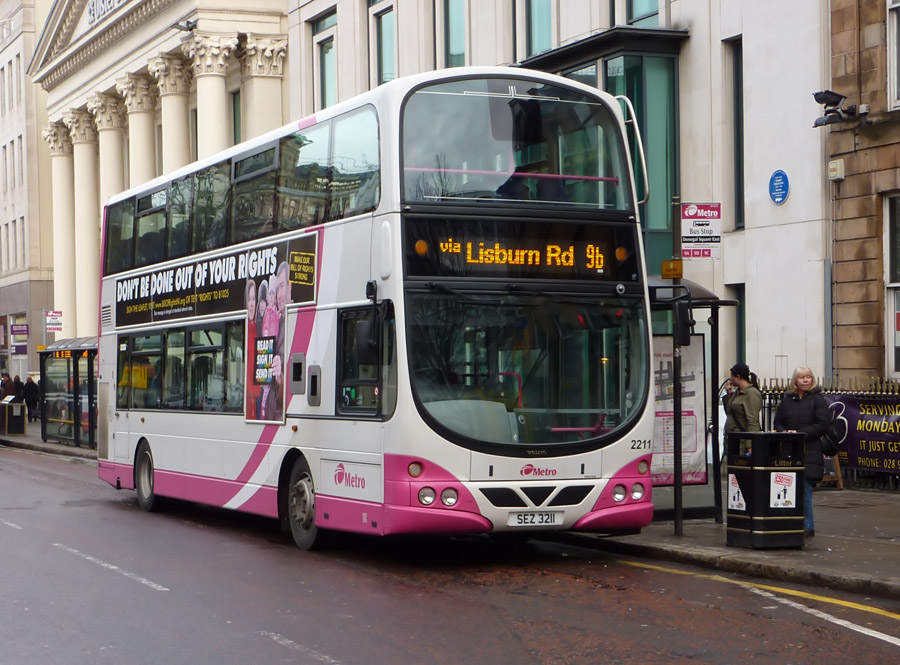
Metro Belfast's 2211, a 2008 Volvo B9TL Wright Gemini, is seen on Donegal Square East operating Route 9b to Balmoral on the 16/1/2010. The 9b is one of 3 routes (9a/b/c) which make up the Lisburn Road QBC and operate with a daytime frequency of 7-8 minutes. 2211 is interesting in that it was one of 20 Gemini's delivered in May 2008, but its registration is out of sequence, all the others having a reg number that matches their fleet number.
Belfast's Bus Services are run under the Metro trading name, which is run as part of the overall Translink group (similar to the CIE group). In February 2005 Belfast's bus operations were completely redefined with the launch of the Metro network. This network saw the bus services in the city simplified around 12 Quality Bus Corridors (QBCs), which are designed to have frequencies between 5 and 10 minutes during peak hours. These routes are direct, arterial routes, however operating in tandem are less frequent, less direct, socially important services that meander around to link important city locations, while also serving large estates off the QBC itself.
The method in which Belfast's services changed is quite interesting. Like many other cities in the UK at the time these changes occured overnight, along with a livery change and a new operating name. It was noted at the time that it was the first major redesign of the system for over 30 years. In Dublin, one could argue the system has never really been redesigned, more often chopped and changed haphazardly in order to suit growing demand while still retaining services that are less socially necessary. The amalgamations of bus routes in the 90's in order to have higher frequencies have left Dublin with many services that just meander around miles and miles of estates.
Dublin Bus is in the course of performing a network review which will look to realign the bus provisions with the needs and demands of the wider population. This may well work out to be very similar in principal to the Belfast redesign as shown by new routes such as the 4, 128 and 140 which are all direct QBC services. Ideals of the 50's to serve each major housing estate along the way may be dropped in favour of principal key routes with low frequency socially important services running alongside. However it is not envisaged that this network redesign would happen over night, but instead would happen over a certain period of time.

Wright Solar Scania L94UB No. 797, dating from late 2003, is seen on Donegal Square West on the 16/1/10 operating the Holywood Road QBC route 3a to Knocknagoney. Dot Matrix Displays in Belfast oscillate between displaying the destination and the via points and the display here is shown in its mid point of changing, which is a sweep from left to right.
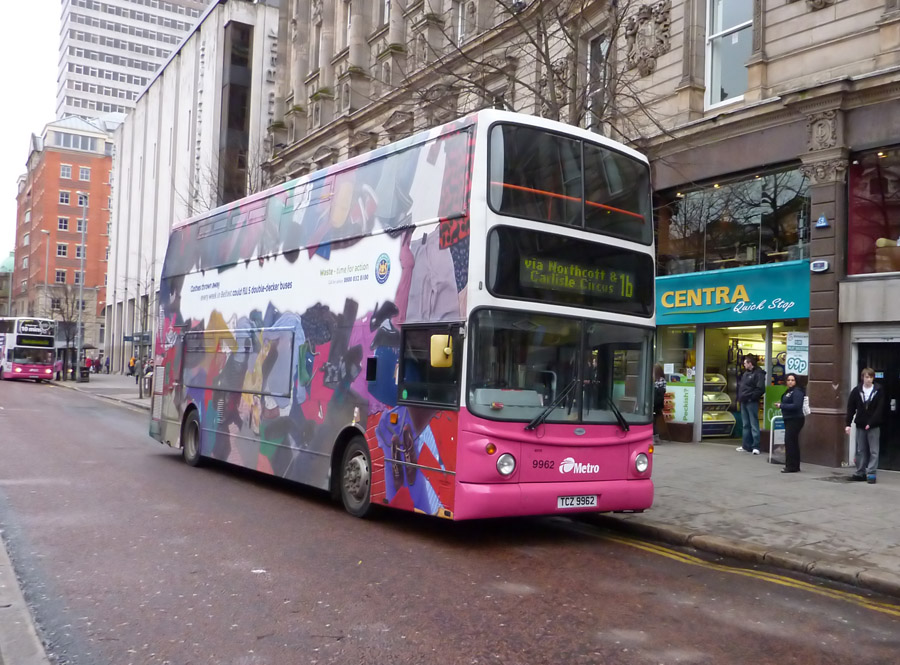
Volvo B7TL Alexander ALX400 No. 9962, dating from 2003 is seen on Donegal Square West on the 16/1/10 operating the Antrim Road QBC Route 1b to Manse Way. The Antrim Road QBC is one of the more complicated in that after Glengormely in can split into no less than 7 routes. 9962 is seen here in a wrap asking passengers to recycle clothing.
In Belfast there are still a lot of less frequent, non-QBC routes. Two of the more interesting are the 19 to the Ulster Hospital and the 13 City Express. The 19 is very much a socially required service operating around the suburbs of east Belfast before terminating at the Ulster Hospital in Dundonald. It meanders for part of its journey around the Melfort estate, notable in that it has what look like bus stops but instead are directional arrows advising drivers where to go in this narrow estate. The 13 on the other hand couldn't be more extreme. Coupled with the 14 it operates in a clockwise loop using the M2 and M5 motorways to get to and from the centre of Belfast before serving some of the more outlying districts of north Belfast, QBC 1 and QBC 2 territory. The 14 operates the same route counter-clockwise.

No. 2979, a Wright Renown bodied Volvo B10BLE dating from 2000, seen laying over at the Ulster Hospital after operating Route 19. Like many services in Belfast this bus changed route on its return operating Route 20 back to the city.
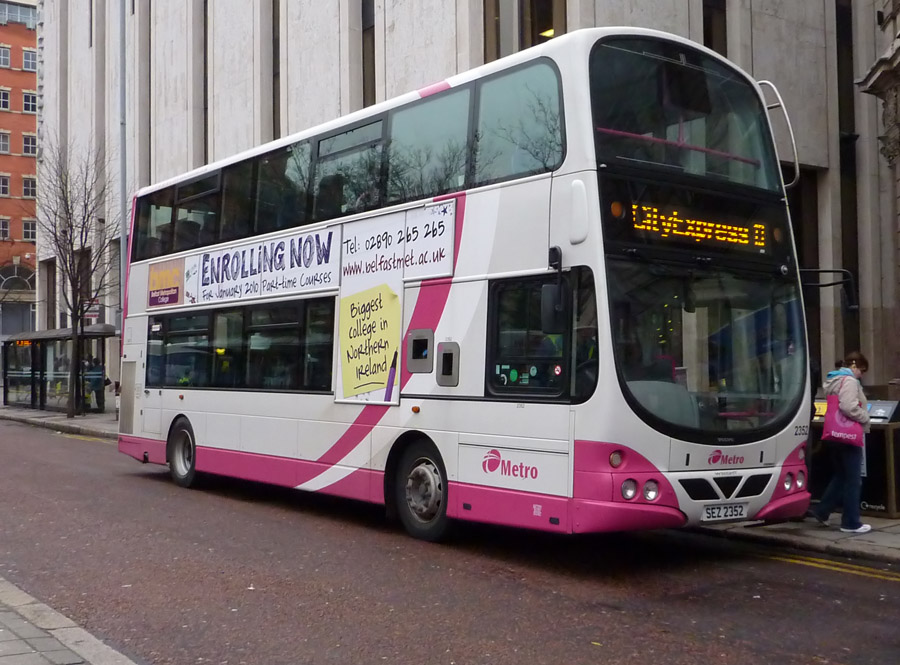
Wright Gemini bodied Volvo B9TL dating from 2008 seen laying over on Donegal Square West having operated the 13 circular City Express service on the 16/1/10.
The Optare Solo has become a vehicle widely used in Northern Ireland. Most operate from provincial Ulsterbus depots but Metro do have a few. Two operating on the 16th January were No's 1833 and 1840, Optare Solo M850s (where 850 refers to their lenght of 8.5m). 1833 was seen on Donegal Square East operating the free Marketlink Service to St. George's Market, the last surviving Victorian covered market in Belfast. It is considered one of Belfast's oldest attractions and as well as being a market acts as a venue for events such as concerts. 1833 carries a rear advertisement for the market, indicating that the bus is free.
1840 is seen on Donegal Place operating a flexibus service to the Northside Park and Ride, a 240 car facility. A 15 min daytime frequency is provided between the hours of 07:45 and 18:30. The picture below is taken on Donegal Place which leads off the main Donegal Square and is generally one of the principal spots to take photographs. Currently however it is undergoing severe roadworks which mean routes have been diverted and the road itself is very cluttered. Hence the over reliance of photographs from Donegal Square in this feature.
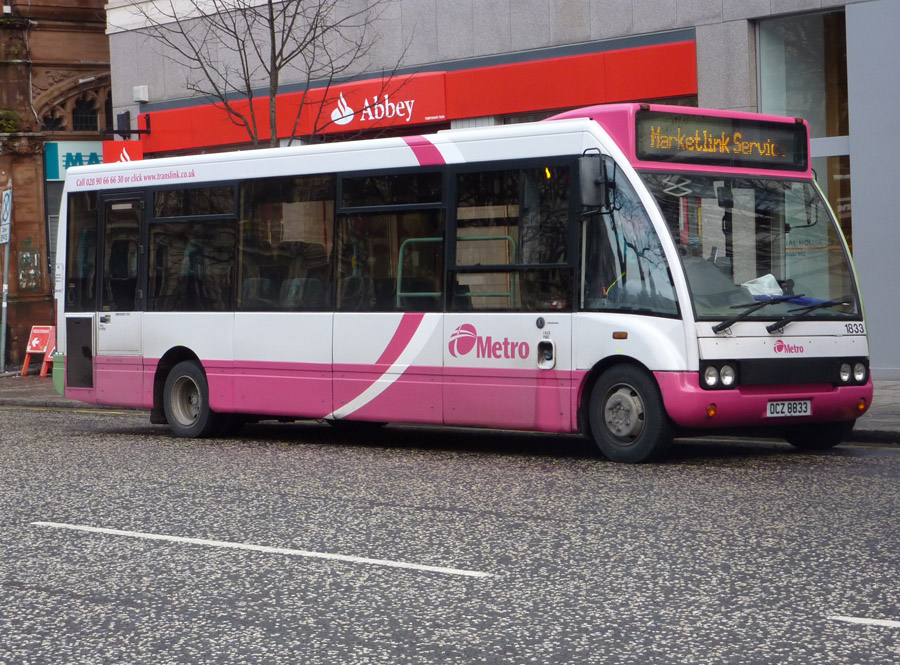
Optare Solo M850 No. 1833 on Donegal Square East operating the MarketLink Service to St. George's Market on the 16/1/2010.
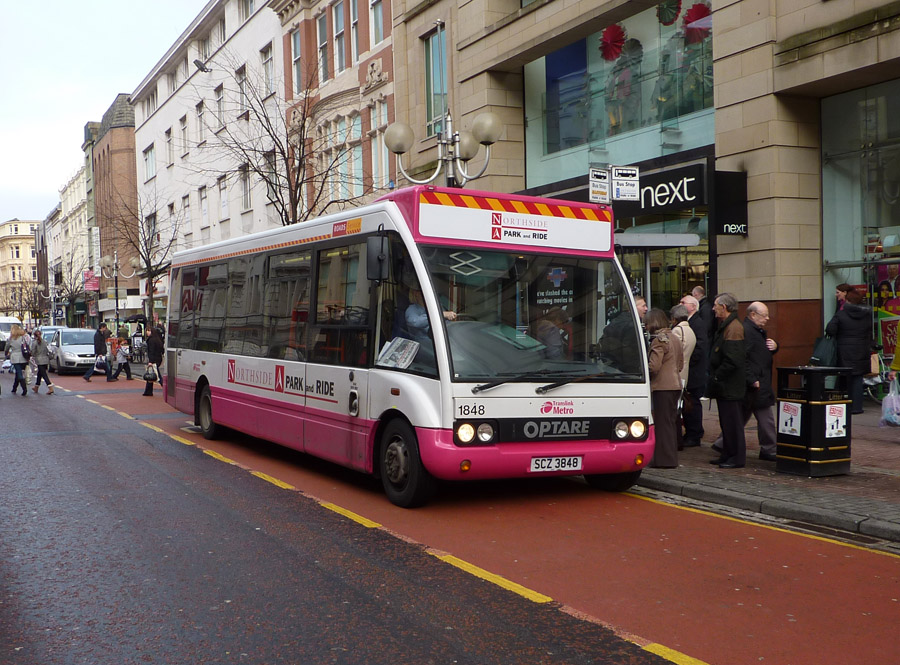
Optare Solo M850 No. 1848 on Donegal Place operating the Northside Park and Ride Service on the 16/1/2010.
The Alexander Ultra Bodied Volvo B10L is known to Dublin Bus enthusiasts as the VL class, a very unsuccessful class of buses with Dublin Bus. The Ultra body was built by Alexander based on a design by Volvo subsidiary Saffle. Originally operated on cross-city route 3 the 6 VLs proved troublesome. Belfast on the other hand seem to like their Ultra's acquiring 62 of them back in the 1990's. Unlike Dublin Bus, Metro sill operate their Ultras and have recently equipped them with orange LED destination displays.

Alexander Ultra Bodied 2738 on the Falls Road QBC route 10f to Lagmore View seen on Queen Street on the 16/1/2010.
The photo below depicts a scene more familiar to Dubliners. Ultra 2714 is seen broken down on Donegal Square East displaying Engineering Testing Route 777. Number 478 is in assistance, a N-bodied Leyland Tiger new in 1986 and converted to an engineering tow-bus in 2008. Originally registered HXI 478 it was reregistered MEZ 5671 in 2007. It comprises a much shorter rear overhang than was the case with the original N-type body, no doubt shortened to improve towing abilities.
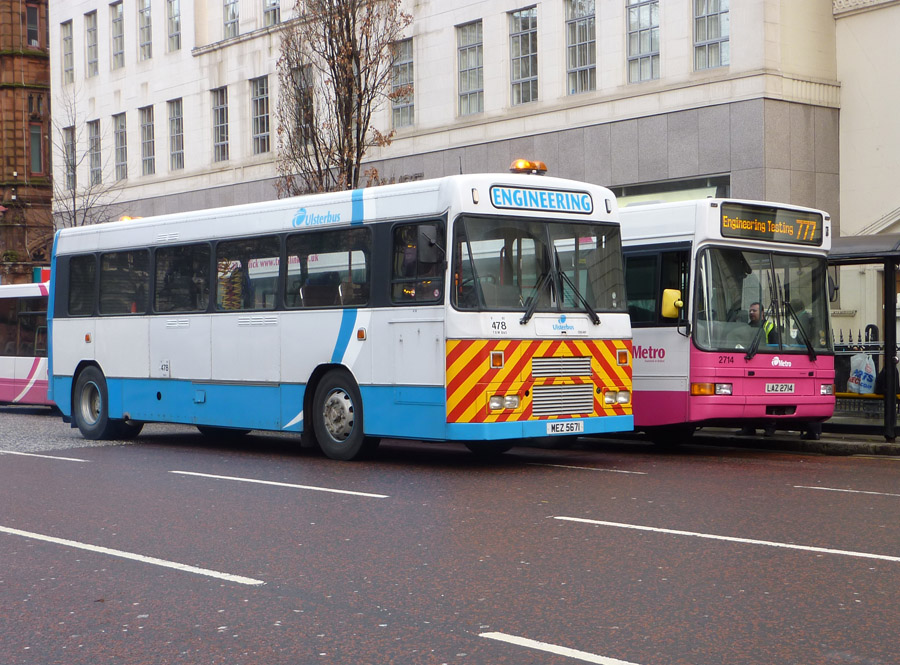
Engineering Vehicle 478 assisting 2714 on Donegal Square East on the 16/1/2010.
The last two photos are from the last journey undertaken before the day was out which was on the Cregagh Road QBC route 6a to Forestside. 2974 operated the outward journey and is seen below already displaying City Centre for its return. The trip to Forestside also allowed a reminiscent trip on an Ultra, 2706 bringing back the memories and also us back into the city to catch the Enterprise to Dublin. It is seen here awaiting time on Wellington Place displaying Route 12a, the Oldpark Road QBC route. As already indicated, buses in Belfast do not spend their time on one route, instead operating a few routes. Therefore it is quite common to see bus destinations changing on buses in service, getting on a bus displaying one thing and off when its displaying another. The darkness of the scene depicts the winter dreariness of the bus enthusiast's world. 5pm in the evening, its dark and difficult, the number of times required to get this photo right indicated by how deeply the driver is now staring at the photographer.

ALX400 bodied VolvoB7TL No. 2974 seen at the 6a terminus at Forestside awaiting its return to the city on the 16/1/2010.
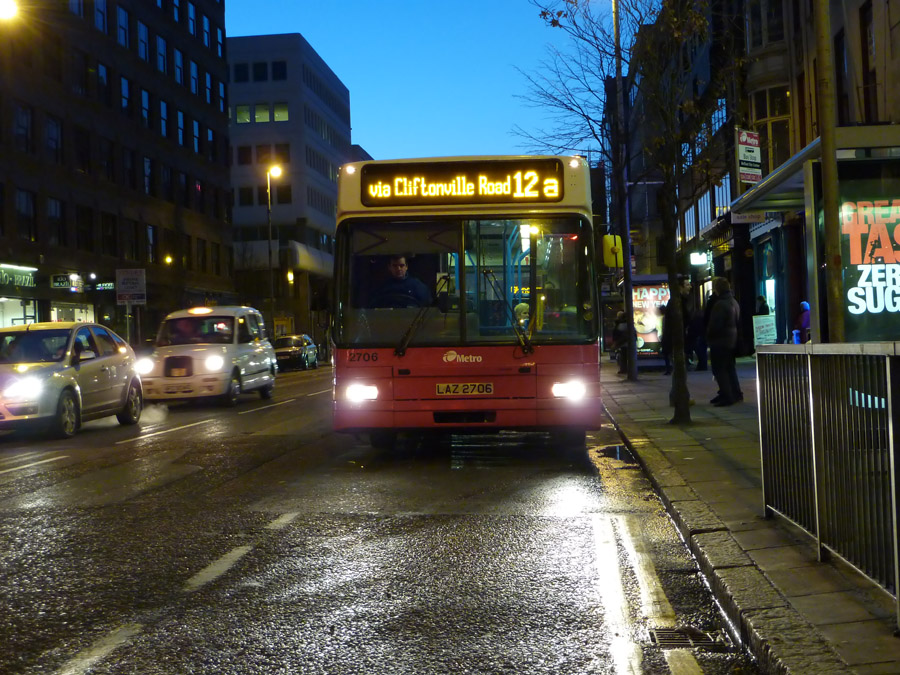
Alexander Ultra Bodied Volvo B10L awaiting its time on Wellington Place for a 12a departure to Car's Glen via Cliftonville Road having just operated a 6a from Forestside on the 16/1/2010.
